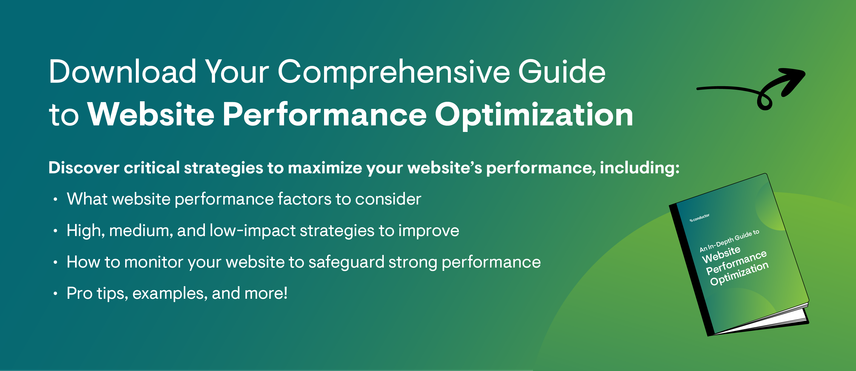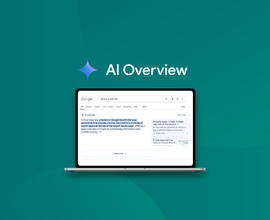Your Comprehensive Guide to Website Performance Optimization
A poorly performing website creates a poor user experience, and users will likely leave your site prematurely and are, over time, less likely to visit your site. As a result, Google will be less likely to rank it well. In fact, even if your website is performing decently, you are still likely to be outranked by sites with superior performance. Which is why optimizing your website’s performance is so critical.
Website performance is tricky to nail down. Your site may work perfectly if you check it now, but you don't know how it performed during the night or a few hours ago.
Before I get on my soapbox about the importance of website performance optimization, let’s back up and explain what we’re talking about when we talk about website performance. Website performance describes how well your website operates when users interact with it. Often, you’ll see website performance narrowed down or folded into the idea of website speed. Website speed is important, to be sure, but it’s not all of website performance. Even fast websites can perform better. It’s also about ensuring your website loads properly on every device, offers HTTPS, and much more.
With this in mind, let’s explore what factors compose website performance, how you can measure it, and what you can do to optimize it.
What is website performance optimization?
Website performance optimization is the process of improving the back and front-end of your website to provide a smooth and efficient user experienceUser Experience
User experience (or UX for short) is a term used to describe the experience a user has with a product.
Learn more. It’s not just about speed either. Your site can load quickly and still not be optimized for performance.
For example, your website may work perfectly for visitors in the US, but a visitor from across the world may have a poor experience because the site is hosted in the US, and you don’t use a CDN. That’s poor performance.
In order to optimize your website’s performance, you need to take a more holistic approach and look at each individual aspect of your website that can affect your website’s speed and performance.
Why is website performance optimization important?
Did you know that every 100ms in added page load time costs 1% in revenue?
Your website is how you interact with your audience, and it’s often their first impression of your brand. How do you want to appear to them? If users visit your website and it loads improperly, uploads images slowly, or constantly loops into redirects, users will leave your site and find a competitor instead. Nobody wants to use a site that has poor UX.
In addition, Google doesn’t want to promote poorly performing websites. Google’s goal is to provide helpful content, answers, and experiences to users. A site with poor website performance provides none of the above. In short, if your website performance isn’t optimized, your site is unlikely to rank well and drive quality traffic.
What are the factors that affect website performance?
Now that you know how important website performance optimization is, let’s talk about what trends and metrics you should be on the lookout for when starting out. Your Core Web Vitals are a good starting point for optimizing performance, but they aren’t everything. For example, we’ll mention multiple strategies to optimize your website performance later that won’t directly improve these Core Web Vitals.
Core Web Vitals offers insights into the loading performance, interactivity, and visual stability of your website. Core Web Vitals have also been used as a direct ranking factorRanking Factor
The term “Ranking Factors” describes the criteria applied by search engines when evaluating web pages in order to compile the rankings of their search results. Ranking factors can relate to a website’s content, technical implementation, user signals, backlink profile or any other features the search engine considers relevant. Understanding ranking factors is a prerequisite for effective search engine optimization.
Learn more by Google since 2021. If you’re unfamiliar, Core Web Vitals are composed of the following three factors:
- Largest Contentful Paint (LCP) refers to the amount of time in seconds it takes for the largest text block or image to render when the page starts loading.
- Interaction to Next Paint (INP): refers to the amount of time in milliseconds from when a user first interacts with your site to when the browser responds.
- Cumulative Layout Shift (CLS): the cumulative score of all unexpected layout shifts within the viewport during a page’s lifecycle.
Those three Core Web Vitals are not everything that goes into your website’s performance. Some remaining factors include non-Core Web Vitals, such as:
- First Contentful Paint (FCP): measures the amount of time it takes any part of the page’s content to render from when a page starts loading.
- Speed Index (SI): measures how quickly the contents of a page are visibly populated during page load.
- Time to Interactive (TTI): measures the time from when the page starts loading to when it's fully interactive.
- Total Blocking Time (TBT): measures the total time in milliseconds between First Contentful Paint (FCP) and Time To Interactive (TTI)
To stay ahead, you’ll need to monitor each of these factors, as well as the usual technical SEO considerations when maintaining your website.
But before you can monitor and optimize your website’s performance, you need to know how to measure it.
How to measure your website’s performance
For starters, you can check your site and page’s Core Web Vitals by taking a quick assessment to see where you stand. But beyond that, there are several tools that are designed to help you measure your website’s performance and monitor it’s technical foundation. For instance, you can leverage free tools like PageSpeed Insights , GTmetrix , Lighthouse , and WebPageTest , which break down how fast specific URLs within your site operate.
Those tools are all very helpful, but they only give you a small glimpse into your overall website performance. Again, your page speed is important, but it’s not everything. That’s why it’s often helpful to have a solution that offers comprehensive insights into your website’s technical performance. Conductor Website Monitoring monitors your website 24/7 and automatically notifies you of any changes or issues within your pages. It also prioritizes each issue so you know which has the largest impact on your performance and can easily take action.
How to optimize your website performance
First things first, there are thousands of things you can do to optimize website performance, and while all of them are important, some will move the needle more. To make this more digestible, we’ve broken down these optimization opportunities into buckets from highest- to lowest impact.

High-impact website performance optimization opportunities
Your high-impact website performance optimization opportunities are big-picture, often heavy-lift strategies that go a long way toward helping you improve. These are the strategies you should consider implementing ASAP if your goal is to optimize your website performance.
Examples of these opportunities include:
- Upgrading to HTTP 2.0
- Utilizing a Content Delivery Network(CDN)
- Optimizing your site’s compression
- Caching (both on the client and server-side).
Medium-impact website performance optimization opportunities
After you've implemented the high-impacted opportunities, continue with the medium-impact ones. But what does a medium-sized website performance opportunity look like?
Many of these solutions revolve around ensuring that everything on your website is where it’s supposed to be and that it’s not using unnecessary resources. Examples of these opportunities include:
- Optimizing your database performance
- Removing unused plugins
- Avoiding render-blocking resources
Low-impact website performance optimization opportunities
Repeat after me: Low impact does not mean low importance. It just means that these factors won’t have the same impact on your performance as the other methods we mentioned above.
Examples of these opportunities include:
- Compressing images
- Removing redirects
- Employing the correct image sizes and formats
- Optimizing web fonts

How to monitor your website performance
The good news about website performance is that you can improve it. The bad news is that optimizing your website performance is not a one-off activity. Like anything else involving your website, you need to monitor it regularly to ensure that issues haven’t arisen and that any changes you may have made are having their intended impact.
As we mentioned above, Conductor Website Monitoring audits your entire website 24/7 so that you’re constantly aware of everything happening on your site. If redirects are causing havoc or pages are loading slowly, Conductor Website Monitoring will flag the issue to you so that you can take steps to resolve it before your UX, rankingsRankings
Rankings in SEO refers to a website’s position in the search engine results page.
Learn more, traffic, and, ultimately revenue take a hit.
Website Performance Optimization in review
Ultimately, your website’s performance is critical to your growth potential. If your website is performing well, then users will be more likely to visit your website and remain there. It also increases the possibility that they return to your site when they have similar questions. While strong website performance isn’t a substitute for great and helpful content, it is definitely a needle mover when it comes to rankings, wince Google factors website performance and site speed into its rankings. In short, an optimized website performance is the key to maximizing your user experience, traffic, and ROI through search.








